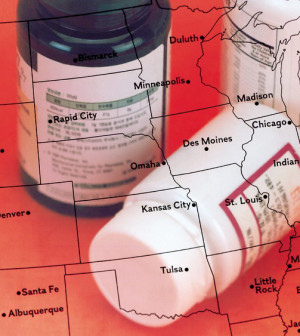- Navigating Your Midlife Crisis: Embracing New Possibilities
- City Raccoons Showing Signs of Domestication
- Mapping the Exposome: Science Broadens Focus to Environmental Disease Triggers
- One Week Less on Social Media Linked to Better Mental Health
- Your Brain Changes in Stages as You Age, Study Finds
- Some Suicide Victims Show No Typical Warning Signs, Study Finds
- ByHeart Formula Faces Lawsuits After Babies Sickened With Botulism
- Switch to Vegan Diet Could Cut Your Greenhouse Gas Emissions in Half
- Regular Bedtime Does Wonders for Blood Pressure
- Dining Alone Could Mean Worse Nutrition for Seniors
Teens With History of Self-Poisoning Face Greater Suicide Risk


Teens who survive self-poisoning with drugs are at a significantly increased risk for suicide over the following decade, a new study shows.
“Self-poisoning in adolescence is a strong predictor of suicide and premature death in the ensuing decade, and identifies a high-risk group for targeted prevention,” study co-leader Dr. Yaron Finkelstein said in an American Academy of Pediatrics news release.
“Suicide risk is markedly increased for many years after the first hospital presentation, emphasizing the importance of sustained prevention efforts in this vulnerable population,” added Finkelstein, a staff physician in the divisions of emergency medicine and clinical pharmacology and toxicology at The Hospital for Sick Children in Toronto.
The new study included more than 20,000 teens in the province of Ontario who were treated at hospital emergency rooms for self-poisoning. The researchers followed up on the teens for 12 years or until they died. The teens who had been treated for self-poisoning were compared with more than 1 million teens who hadn’t tried to poison themselves.
The median age of the teens when they left the hospital after the first self-poisoning episode was 16. Just over two-thirds of these teens were girls. Acetaminophen — a pain reliever — was the most widely used substance in the self-poisoning attempts, followed by antidepressants and nonsteroidal anti-inflammatory drugs, the study revealed.
During the follow-up, almost 250 teens who had previously poisoned themselves died. Suicide accounted for more than half those deaths. The suicide risk among these teens was more than 30 times higher than among their peers in the general population, according to the study.
The researchers noted that the increased risk of suicide lasted for years. Half of the suicides occurred more than three years after the first self-poisoning attempt.
Factors associated with suicide included more attempts at self-poisoning, being male, and being in psychiatric care in the preceding year. Teens hospitalized for self-poisoning were also more likely to die in accidents than those in the general population, the study found.
Suicide is the third leading cause of death among American teens, and poisoning is the most common method of attempted suicide, according to the U.S. Centers for Disease Control and Prevention. In the past decade, hospital admission rates for suicidal ideation and attempts by American children have more than doubled, the researchers added.
The study was to be presented Saturday at the Pediatric Academic Societies annual meeting in San Diego, and will be published simultaneously in The Lancet Psychiatry.
More information
The American Academy of Child and Adolescent Psychiatry has more about teen suicide.
Source: HealthDay
Copyright © 2025 HealthDay. All rights reserved.










